Samsung SSD 840 EVO Review: 120GB, 250GB, 500GB, 750GB & 1TB Models Tested
by Anand Lal Shimpi on July 25, 2013 1:53 PM EST- Posted in
- Storage
- SSDs
- Samsung
- TLC
- Samsung SSD 840
Random Read/Write Speed
The four corners of SSD performance are as follows: random read, random write, sequential read and sequential write speed. Random accesses are generally small in size, while sequential accesses tend to be larger and thus we have the four Iometer tests we use in all of our reviews.
Our first test writes 4KB in a completely random pattern over an 8GB space of the drive to simulate the sort of random access that you'd see on an OS drive (even this is more stressful than a normal desktop user would see). I perform three concurrent IOs and run the test for 3 minutes. The results reported are in average MB/s over the entire time. We use both standard pseudo randomly generated data for each write as well as fully random data to show you both the maximum and minimum performance offered by SandForce based drives in these tests. The average performance of SF drives will likely be somewhere in between the two values for each drive you see in the graphs. For an understanding of why this matters, read our original SandForce article.
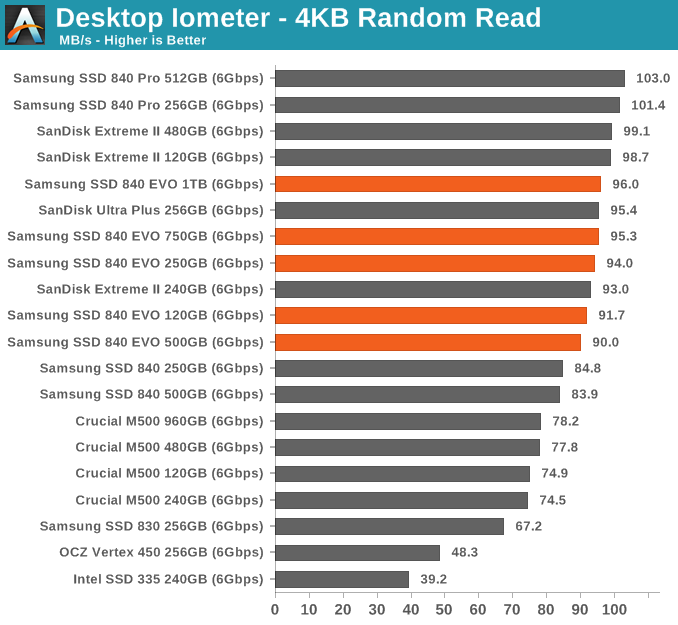
Random read speed is very close to that of the 840 Pro. The EVO doesn't look like a mainstream drive here at all.
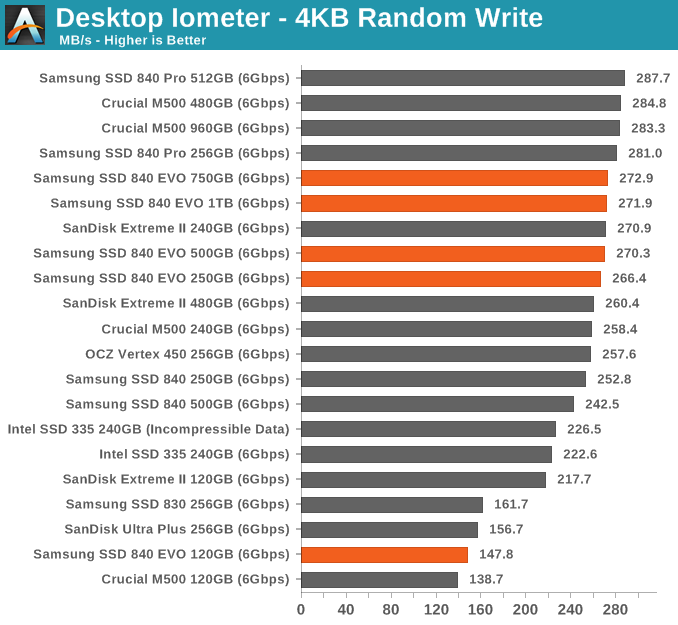
Even peak random write performance is dangerously close to the 840 Pro. Only the 120GB drive shows up behind the pack. I should add that I'll have to redo the way we test 4KB random writes given how optimized current firmwares/architectures have become. The data here is interesting but honestly the performance consistency data from earlier is a better look at what happens to 4KB random write performance over time.
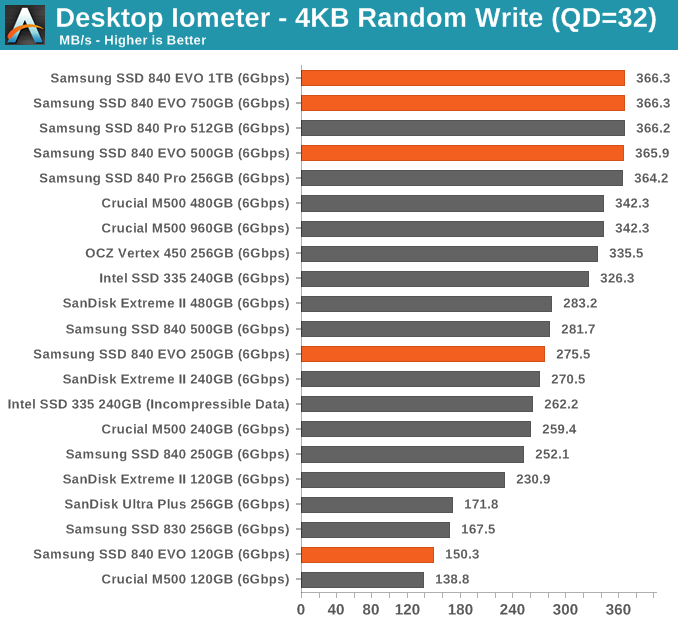
The relatively small difference between QD3 and QD32 random write performance shows you just how good of a job Samsung's controller is doing at write combining. At high queue depths the EVO is just as fast as the 840 Pro here. So much for TLC being slow.
Sequential Read/Write Speed
To measure sequential performance I ran a 1 minute long 128KB sequential test over the entire span of the drive at a queue depth of 1. The results reported are in average MB/s over the entire test length.
Sequential read and write performance, even at low queue depths is very good on the EVO. You may notice lower M500 numbers here than elsewhere, the explanation is pretty simple. We run all of our read tests after valid data has been written to the drive. Unfortunately the M500 attempts to aggressively GC data on the drive, so even though we fill the drive and then immediately start reading back the M500 is already working in the background which reduces overall performance here.
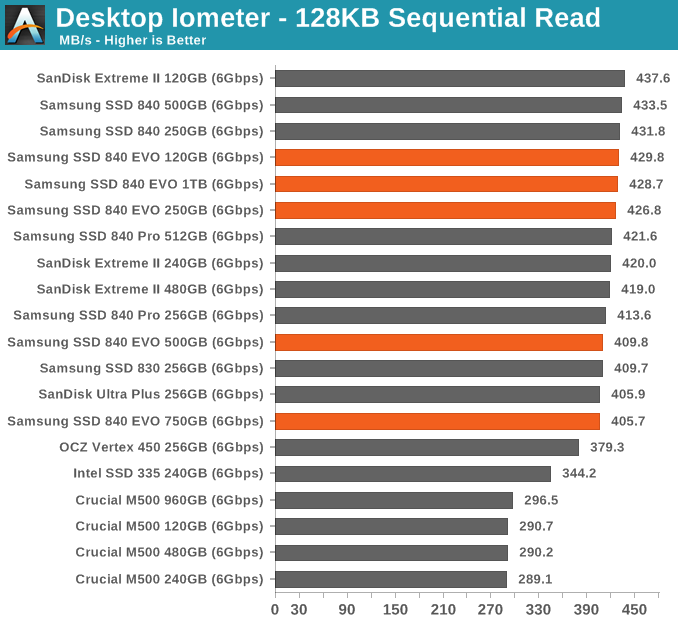
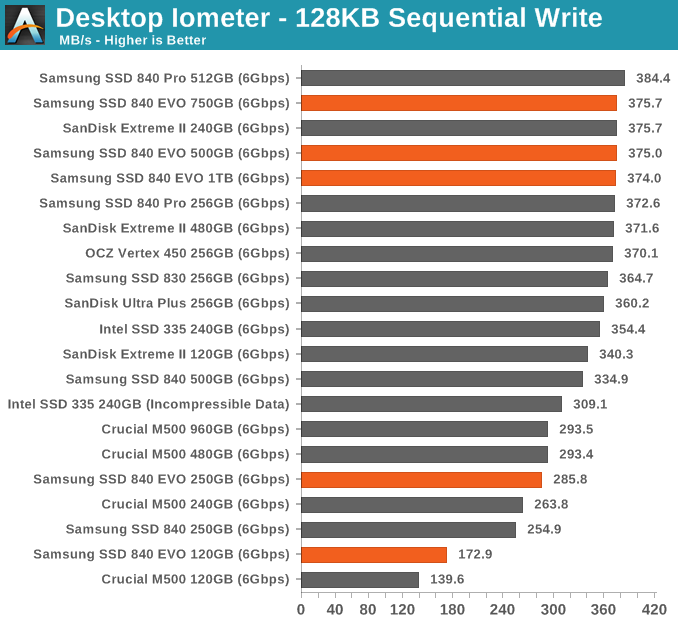
AS-SSD Incompressible Sequential Read/Write Performance
The AS-SSD sequential benchmark uses incompressible data for all of its transfers. The result is a pretty big reduction in sequential write speed on SandForce based controllers.
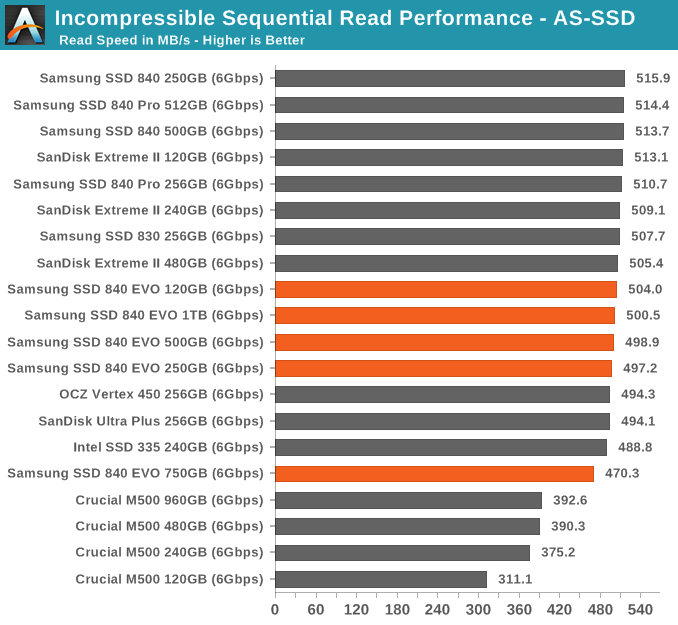
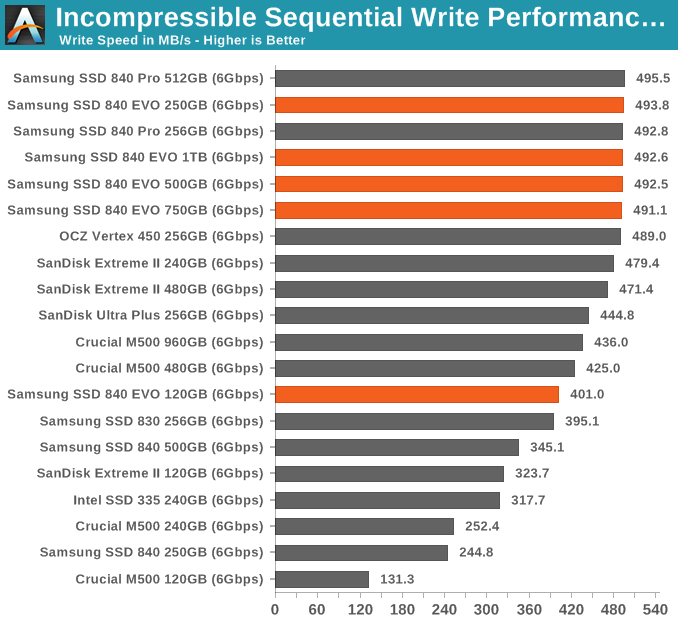










137 Comments
View All Comments
Sivar - Thursday, July 25, 2013 - link
Really well-written article.I have to admit, while most of Samsung's products are crap, their 840 and later SSDs are not bad at all.
(The 830, while not prone to electronic failure, was built really poorly. It's SATA connector would snap off if you tilted your head the wrong way while looking at it).
Coup27 - Thursday, July 25, 2013 - link
Samsung have gotten into the world position they are in today by selling crap. I have used plenty of 830's and I have never had an issue with the SATA connector so I have no idea what you are doing with it.Coup27 - Thursday, July 25, 2013 - link
Haven't ^^ (why is there no edit button?)piroroadkill - Thursday, July 25, 2013 - link
So you accidentally broke a SATA connector, and now that's suddenly a flaw? I have two Samsung 830 256GB in my system, and somehow I didn't break the SATA connectors...I also fitted 4x Samsung 830 256GB to a server at work.. and somehow I didn't break the SATA connectors..
HisDivineOrder - Saturday, July 27, 2013 - link
True, this. SATA connectors are poorly designed, but that's the fault of the people who made the spec, not the specific one in the 830. I'm not saying it can't break. I've had SATA connectors break on a variety of devices. None of them were my 830, but I'm not saying it's impossible or whatever.I've seen WD, Seagate, and Hitachi drives all have a problem with the connector, though. Seems like SATA and HDMI were designed to make the connection as loose and easily broken as possible. I guess that gives them some small percentage of people buying all new product to replace something on said product that's small and plastic...
mmaenpaa - Thursday, July 25, 2013 - link
Good article once again Anand,and very good perfomance for this price range.
Regarding Torx, I believe this is one the main reasons why it is used:
"By design, Torx head screws resist cam-out better than Phillips head or slot head screws. Where Phillips heads were designed to cause the driver to cam out, to prevent overtightening, Torx heads were designed to prevent cam-out. The reason for this was the development of better torque-limiting automatic screwdrivers for use in factories. Rather than rely on the tool slipping out of the screw head when a torque level is reached, thereby risking damage to the driver tip, screw head and/or workpiece, the newer driver design achieves a desired torque consistently. The manufacturer claims this can increase tool bit life by ten times or more"
(from https://en.wikipedia.org/wiki/Torx)
BR,
Markku
hybrid2d4x4 - Thursday, July 25, 2013 - link
For what it's worth, my experience with screws is consistent with your post. I've never had a torx screw slip out, which is definitely not the case with philips or the square or flathead varieties. I'd like to see them used more often.piroroadkill - Thursday, July 25, 2013 - link
Agreed. I love Torx. Philips and pozidriv are the terrible bastard children of the screw universe. Always slipping and burring. Ugh. If everything was replaced with totally cam-out free designs like Torx, allen head, robertson screw.. etc, etc.. then I'd be more than happy.psuedonymous - Thursday, July 25, 2013 - link
I'd LOVE for Torx to be used more often. They're much easier to work with (not once have I had a Torx screw fall off the screwdriver and roll under the desk), the screwheads are more robust, and they frankly look a lot nicer than Philips or Pozidriv.It'd make pulling apart laptops all day a darn sight less onerous if Torx were the standard rather than Philips.
camramaan - Friday, February 14, 2014 - link
But then there would be less security in other areas of the mechanical world... not everyone can carry a bunch of Torx bits everywhere they go, so breaking into, or disassembling something built with Torx is more time laborious and pre-planned. I fully understand the sentiments, but the development of alternative screw heads was more for security than ease of use.